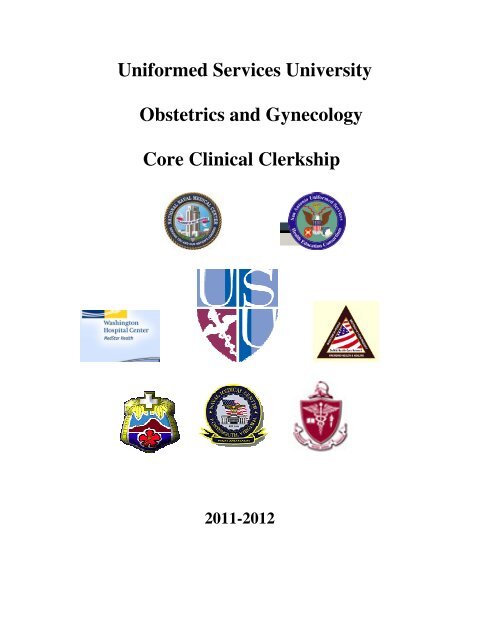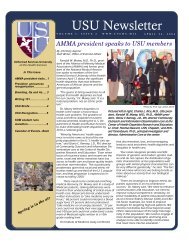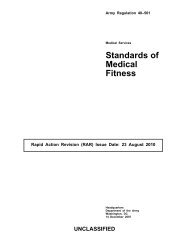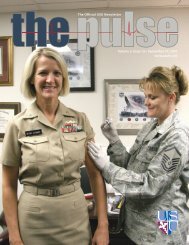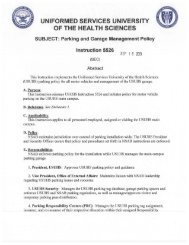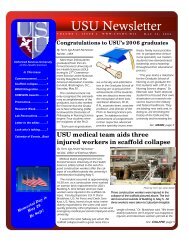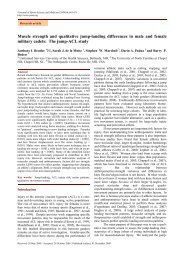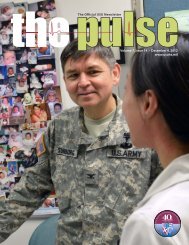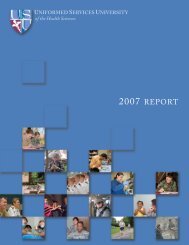Uniformed Services University Obstetrics and Gynecology Core ...
Uniformed Services University Obstetrics and Gynecology Core ...
Uniformed Services University Obstetrics and Gynecology Core ...
You also want an ePaper? Increase the reach of your titles
YUMPU automatically turns print PDFs into web optimized ePapers that Google loves.
<strong>Uniformed</strong> <strong>Services</strong> <strong>University</strong><strong>Obstetrics</strong> <strong>and</strong> <strong>Gynecology</strong><strong>Core</strong> Clinical Clerkship2011-2012
UNIFORMED SERVICES UNIVERSITY OF THE HEALTH SCIENCESDEPARTMENT OF OBSTETRICS AND GYNECOLOGY4301 JONES BRIDGE ROADBETHESDA, MD 20814Third Year Medical Students:Welcome to your third year <strong>Obstetrics</strong> <strong>and</strong> <strong>Gynecology</strong> Clinical Clerkship! <strong>Obstetrics</strong> <strong>and</strong><strong>Gynecology</strong> is an exciting <strong>and</strong> unique field of medicine! In the span of one day, you may perform asurgery, deliver a baby, evaluate an elderly woman with ovarian cancer, <strong>and</strong> counsel a 15 year-oldabout prevention of pregnancy <strong>and</strong> sexually-transmitted infections. <strong>Obstetrics</strong> <strong>and</strong> gynecology offersbreadth within the focus of women’s health care. Over the next six weeks, you will experience manysides to women’s health care that you may not have even known about.The bulk of your clerkship will be made up of the clinical experiences you receive in obstetrics,gynecology, <strong>and</strong> ambulatory settings. The clerkship is designed with a problem-based learningapproach. This means that the core concepts, <strong>and</strong> many of the objectives, are met by using samplepatient cases for discussion with your peers <strong>and</strong> a preceptor each week. There are no traditionallectures other than those you may receive on gr<strong>and</strong> rounds at various sites.During the clerkship you will be required to maintain a “Clinical Encounter Card” to ensure youreceive appropriate feedback from preceptors. You will also be required to complete <strong>and</strong> turn in 2case write-ups; these cases require a written H&P <strong>and</strong> an oral presentation. These requirements willbe reviewed in more detail at your orientation. Additionally, we have developed a curriculum throughSAKAI, which will allow you to keep track of all of your assignments. You will be asked to write aprescription, an operative report, admission orders, <strong>and</strong> a delivery summary during your rotation onSAKAI. Please check your email frequently.The final examination includes an Objective Structured Clinical Examination (OSCE). And theNational Board of Medical Examiners (NBME) subject examination in OB/GYN. You must pass theNBME exam to pass this course. Please check your email weekly for any changes <strong>and</strong>/or updatesregarding this rotation.<strong>Obstetrics</strong> <strong>and</strong> gynecology is an exciting specialty, <strong>and</strong> I think you will find your rotation to bechallenging, rewarding, <strong>and</strong> fulfilling. If you need to meet with me for any clerkship related issues,please do not hesitate to arrange an appointment or phone conference by contacting the departmentClerkship Coordinator, Ms. Tanya Christian, at (301) 295-3777, or you can email me directly atlaura.ramsay@usuhs.mil. We look forward to your upcoming rotation!Sincerely,Laura Ramsay, MDLCDR MC USNAssistant ProfessorDirector of Clinical Clerkships
IMPORTANT CONTACT INFORMATION:CLERKSHIP COORDINATOR:Ms. Tanya ChristianPhone: (301) 295-3777FAX: (301) 295-0419Email: tchristian@usuhs.milCLERKSHIP DIRECTOR:Laura Ramsay, MDLCDR MC USNPhone: (301) 295-3777 or 295-6009Pager: 1-866-295-4913 PIN: 1065041Email for pager texts: 1065041@skytel.comEmail: laura.ramsay@usuhs.milOBSTETRICS AND GYNECOLOGY ADMINISTRATIVE OFFICER:Ms. Tracy SmithPhone: (301) 295-3430Email: tsmith@usuhs.milDEPARTMENT CHAIRMAN:Christopher M. Zahn, MDCol, USAF, MCPhone: (301) 295-3430Email: czahn@usuhs.mil
SITE COORDINATOR CONTACT INFORMATION:Walter Reed National Military Medical CenterMAJ (P) Kimberly Hickey, MC, USA (Maternal-Fetal-Medicine)8901 Wisconsin Ave.Bethesda, MD 20889-5600Phone: (301) 319-5050/4254Email: kimberly.hickey@med.navy.milTripler Army Medical CenterLTC Tiki Bakhshi, MC, USA1 Jarrett White Road, Room 4G505Tripler Army Medical Center, HI 96859-5000Pager: (808) 577-5563Email: tiki.bakhshi@amedd.army.milDeWitt Army Community HospitalKristi Wood, MC USN9501 Farrell Road, Suite GC 11Ft. Belvoir, VA 22060-5141Phone: (703) 719-1157 (Pgr)(703) 805-0816 (O)Email: kristi.wood@amedd.army.milWashington Hospital CenterVeronica Gomez-Lobo, MD110 Irving Street NWWashington, DC 20010Phone: (202) 877-3029Email: veronica.gomez-lobo@medstar.net
San Antonio Military Medical CenterYashika Dooley, USAF, MCDepartment of <strong>Obstetrics</strong> <strong>and</strong> <strong>Gynecology</strong> (MCHE-OG)San Antonio Military Medical CenterBuilding 36003851 Roger Brooke DriveFort Sam Houston, TX 78234-6200Phone: 210-916-2525 (DSN 429)Email: yashika.dooley@amedd.army.milNaval Medical Center PortsmouthCDR Stuart Shippey, MC USNDepartment of <strong>Obstetrics</strong> <strong>and</strong> <strong>Gynecology</strong>620 John Paul Jones CirclePortsmouth, VA 23708Phone: 757-953-2394Email: stuart.shippey@med.navy.mil
Link to interactive self-examination for multiple use during the rotation.To access APGO uWise please go to the following link:www.apgo.org click on elearn then click on uwiseThe user name is: usuhsThe password is: uwise146
THIRD YEAR CLINICAL CLERKSHIPDepartment of <strong>Obstetrics</strong> <strong>and</strong> <strong>Gynecology</strong>F. Edward Hébert School of Medicine<strong>Uniformed</strong> <strong>Services</strong> <strong>University</strong> of the Health SciencesThe six-week third year clinical clerkship in obstetrics <strong>and</strong> gynecology is conducted atthe following six sites:Fort Belvoir Community HospitalWalter Reed National Military Medical CenterTripler Army Medical CenterWashington Hospital CenterSan Antonio Military Medical CenterNaval Medical Center PortsmouthThis introduction presents the policies <strong>and</strong> guidelines of the clerkship that have been established bythe Department of <strong>Obstetrics</strong> <strong>and</strong> <strong>Gynecology</strong> at the <strong>Uniformed</strong> <strong>Services</strong> <strong>University</strong> of the HealthSciences. Information unique to each facility will be provided to you by the onsite clerkshipcoordinator at the beginning of your rotation.Outline of Manual:I. Clerkship Componentsa. Clinical Experienceb. Problem-Based Learning Sessionsc. Self-Directed Modulesd. Case Presentationse. Clinical Encounter Cardsf. WebLog Entryg. Objective Structured Clinical Examinationh. National Board of Medical Examiners Written ExaminationII. Instructional ObjectivesIII.IV.Assigned Reading MaterialsGrading Policya. Student Performance Evaluationb. Midterm Evaluationc. Case Presentation Grading FormV. Attendance PolicyVI. Student Evaluation of ClerkshipVII. Suggested ResourcesVIII. Obstetric <strong>and</strong> Gynecologic HistoryIX. Obstetric <strong>and</strong> Gynecologic Physical ExaminationX. Survival TipsXI. Sample Notes <strong>and</strong> PresentationsXII. Glossary of Common TermsXIII. List of Common Acronyms
I. Clerkship Components:The <strong>Obstetrics</strong> <strong>and</strong> <strong>Gynecology</strong> clerkship is composed of your clinical experience,problem-based learning sessions (PBLs), case presentations, clinical encounter cards,an objective structured clinical examination (OSCE), <strong>and</strong> a written examination fromthe National Board of Medical Examiners.a. Clinical ExperienceYour clinical experience will include obstetrics <strong>and</strong> gynecology, including surgery <strong>and</strong>ambulatory care. In some cases, you may receive a portion of your gynecologyexperience on a subspecialty team such as gynecologic oncology or reproductiveendocrinology <strong>and</strong> infertility. During your clinical experience, the staff <strong>and</strong> residentsthat work with you will grade you on your cognitive <strong>and</strong> noncognitive academicperformance.The cognitive academic performance grade accounts for 20% of your final grade,<strong>and</strong> is based on your performance on the wards, written histories <strong>and</strong> physicalexamination, progress notes, participation <strong>and</strong> knowledge during rounds <strong>and</strong>conferences, skill with oral case presentations, skill in performing technicalprocedures, <strong>and</strong> ability to analyze data, formulate appropriate problem lists(differential diagnosis), <strong>and</strong> make clinical judgments. It is also based on your use oftexts <strong>and</strong> journals.Noncognitive academic performance accounts for 30% of your final grade <strong>and</strong> isbased on your ability to appropriately relate to staff, peers, <strong>and</strong> patients, as well asyour professional demeanor, maturity, <strong>and</strong> moral <strong>and</strong> ethical conduct. It is also basedon the demonstration of commitment to, responsibility for, <strong>and</strong> involvement in clinicallearning <strong>and</strong> patient care, including attendance, promptness, <strong>and</strong> availability for allassignments.This information is acquired from evaluations completed by the residents, staffphysicians, on-site clerkship coordinators, <strong>and</strong> nursing staff that you have worked withduring your clinical experience.b. Problem-Based Learning Sessions:The <strong>Obstetrics</strong> <strong>and</strong> <strong>Gynecology</strong> clerkship teaches the core concepts by way ofproblem-based learning (PBL). This has replaced the more traditional method oflectures. PBL involves a weekly interactive discussion between the students <strong>and</strong> apreceptor about various obstetric <strong>and</strong> gynecologic cases. The cases are designed toreflect the educational topics designated by the Association of Professors of<strong>Gynecology</strong> <strong>and</strong> <strong>Obstetrics</strong> (APGO). You will typically cover 5 cases each week atyour PBL session, <strong>and</strong> will also have self-directed case modules to review at your ownpace.
These PBL cases are available in your clerkship manual <strong>and</strong> on our website(www.usuhs.mil) under “School of Medicine” – Department of <strong>Obstetrics</strong> <strong>and</strong><strong>Gynecology</strong> – Medical Student Programs – MSIII clerkship – Problem-BasedLearning Cases.The cases are matched to a chapter in your text for reading. In addition, a quiz isavailable for each PBL case <strong>and</strong> will be administered during the session. This is to aidyou in self-evaluation so you will know how well you are preparing for the writtenexamination. To prepare for these sessions, it is essential that you read thecorresponding text chapter <strong>and</strong> the case, as well as any additional reading on thesubject matter. The quiz grades are used by the site coordinators as part of yourmidrotation feedback so that you may develop strategies for preparation for the writtenexamination. However, your scores on the quizzes are not directly calculated inyour final grade.c. Self-Directed ModulesSeveral self-directed modules are available for your review throughout the course atyour leisure. These modules are important, as they review additional APGOEducational Topics not covered in the PBL sessions. In our clerkship manual, selfdirectedmodules are referenced throughout the clerkship, but you may complete themwhenever it works best for you. These modules are available on our website(www.usuhs.mil) under “School of Medicine” – Department of <strong>Obstetrics</strong> <strong>and</strong><strong>Gynecology</strong> – Medical Student Programs – MSIII clerkship – Self-DirectedModules.d. Case PresentationsDuring your clerkship, you are required to write-up <strong>and</strong> present 2 patient cases thatyou have participated in during the clerkship. One case must be an obstetrics case<strong>and</strong> one must be a gynecology case. You will present the cases orally to anassigned preceptor(s) who will grade your performance <strong>and</strong> provide constructivefeedback on your note-writing <strong>and</strong> oral presentation skills. These write-ups areintended to be thorough H&Ps, NOT abbreviated progress notes or focused clinicpatient notes. It is YOUR RESPONSIBILITY to arrange these sessions with yourassigned preceptor. Your site director can assist you with this process if needed. Youshould also pose a clinical question which prompts a literature search related to thecase. It’s also YOUR RESPONSIBILITY to bring the graded sheet to Dr. Ramsay onthe day of your shelf exam if you will be taking the shelf at USUHS. Tripler <strong>and</strong> SATXstudents can give them to your site directors.Your oral presentations <strong>and</strong> write-up account for 10% of your final clerkship grade.e. Clinical Encounter CardsYou are required to carry your Clinical Encounter Card with you at all times. Thesecards list a variety of clinical encounters which we expect you to have evaluatedduring your rotation. Upon completion of each individual encounter, have yourpreceptor sign the card <strong>and</strong> write observations <strong>and</strong> feedback. The encounter card
signature is only valid if actual feedback or comments are made by thepreceptor. The purpose of this card is to ensure that we receive ample faculty <strong>and</strong>resident feedback on your performance so as to write an appropriate narrativesummary. Your dedication to completion of this card is considered professionalperformance <strong>and</strong> is factored into your non-cognitive performance grade.f. SAKAI AssignmentsYou will be assigned 4 separate web-based assignments through SAKAI, includingwriting a prescription, a delivery summary, an operative report, <strong>and</strong> a deliverysummary. You are required to complete these <strong>and</strong> will be given feedback from Dr.Ramsay. However, this is formative only <strong>and</strong> will not be calculated into your finalgradeg. Objective Structured Clinical Examination (OSCE)This exam accounts for 10% of your final grade <strong>and</strong> is designed to evaluatetechnical, problem-solving, interpersonal, <strong>and</strong> communication skills that are an integralpart of providing care for patients. The skills are based on educational topicsrecommended by APGO. These skills are tested by use of st<strong>and</strong>ardized patients,models, <strong>and</strong> record or chart reviews. This exam is administered during the final weekof the rotation.h. National Board of Medical Examiners (NBME) Written ExaminationThis National Board of Medical Examiners (NBME) subject exam accounts for 30% ofyour final grade <strong>and</strong> is a st<strong>and</strong>ardized, two-hour multiple-choice examination, whichis used in the majority of clerkships throughout the country. This exam is administeredduring the last week of the rotation. It is not unheard of for students to receive verygood clinical grades, but fail the exam. DO NOT LET THIS HAPPEN TO YOU by notstudying the textbook.
II.Instructional Objectives:The clinical clerkship in <strong>Obstetrics</strong> <strong>and</strong> <strong>Gynecology</strong> focuses on mastering theprinciples involved in addressing the health care needs of women. Since mostmedical students do not pursue a career in <strong>Obstetrics</strong> <strong>and</strong> <strong>Gynecology</strong>, theclerkship is structured to expose all students to a wide spectrum of femaleconditions, both normal <strong>and</strong> pathologic. With this experience, you will betterunderst<strong>and</strong> the health issues unique to this patient population regardless of yourchosen field of medicineAs third year medical students, you will actively participate in the evaluation <strong>and</strong>management of routine <strong>and</strong> complicated OB/GYN patients in both the inpatient <strong>and</strong>ambulatory care settings over the course of the six week clerkship experience.Under the direct supervision of resident <strong>and</strong> attending staff obstetriciangynecologists,you will interact with patients <strong>and</strong> learn about their specific healthproblems.The objectives for this clerkship are based on the recommendations of theUndergraduate Medical Education Committee of the APGO 8 th edition ofMedical Student Educational Objectives published in 2004. APGO suggests267 educational topics that should be covered during your entire time in medicalschool; 126 are considered Priority 1 (Topics all medical students MUST learn <strong>and</strong>master) with the remaining 141 objectives considered Priority 2 (Topics studentsSHOULD be expected to learn). The complete publication may viewed <strong>and</strong>/ordownloaded from the website www.apgo.org.The third year clerkship at the <strong>Uniformed</strong> <strong>Services</strong> <strong>University</strong> has developed a listof educational objectives based on these “Educational Topics” by use of the PBLs,Self-Directed Modules, OSCE, <strong>and</strong> your clinical experience:Approach to the Patient (APGO Educational Topics Unit 1):1. History2. Physical Examination3. Pap Smear <strong>and</strong> Cultures4. Diagnosis <strong>and</strong> Management Plan5. Personal Interaction <strong>and</strong> Communication Skills6. Preventive Care <strong>and</strong> Health Maintenance<strong>Obstetrics</strong> (APGO Educational Topics Unit 2):1. Maternal Fetal Physiology2. Preconception Care3. Antepartum Care4. Intrapartum Care5. Lactation6. Ectopic Pregnancy
7. Spontaneous Abortion8. Medical <strong>and</strong> Surgical Conditions of Pregnancy9. Preeclampsia / Eclampsia10. Isoimmunization11. Third Trimester Bleeding12. Preterm Labor13. Rupture of Membranes14. Anxiety <strong>and</strong> Depression15. Postterm Pregnancy16. Spontaneous Vaginal Delivery<strong>Gynecology</strong> (APGO Educational Topics Unit 3):1. Contraception <strong>and</strong> Sterilization2. Vulvar <strong>and</strong> Vaginal Disease3. Sexually Transmitted Infections <strong>and</strong> Urinary Tract Infection4. Pelvic Relaxation <strong>and</strong> Urinary Incontinence5. Endometriosis6. Disorders of the Breast7. Gynecologic Procedures – Counseling <strong>and</strong> Knowledge ofReproductive Endocrinology <strong>and</strong> Infertility (APGO Educational Topics Unit4):1. Puberty2. Amenorrhea3. Normal <strong>and</strong> Abnormal Uterine Bleeding4. Dysmenorrhea5. Menopause6. InfertilityNeoplasia (APGO Educational Topics Unit 5):1. Cervical Disease <strong>and</strong> Neoplasia2. Uterine Leiomyomas3. Endometrial Carcinoma4. Ovarian NeoplasmsHuman Sexuality (APGO Educational Topics Unit 6):1.Sexuality <strong>and</strong> Modes of ExpressionViolence Against Women (APGO Educational Topics Unit 7):1. Sexual Assault2. Domestic Violence
The APGO “Essential Elements” listed below are the m<strong>and</strong>atory requirements forcompleting this clerkship. As you will notice, these are met through the PBL sessions<strong>and</strong> in a typical clerkship experience. If you are not experiencing one or more of theessential elements listed below, it is your responsibility to notify your on-siteclerkship coordinator or the clerkship director so that we may arrange an alternateexperience to meet these elements:1. Clinical skills in the medical interview <strong>and</strong> physical exam2. Collect <strong>and</strong> interpret a cervical cytology – first line disposition, limitationsof cervical cytology3. Thorough grounding in modern contraceptive technology4. Differential diagnosis of the “acute abdomen” – pelvic infection, ectopicpregnancy, adnexal torsion, appendicitis, diverticulitis, renal calculi5. Physiologic adjustments that accompany normal gestation, especiallylab test results6. Embryonic <strong>and</strong> fetal development – what does <strong>and</strong> does not affect it;what is <strong>and</strong> is not teratogenic.7. Health <strong>and</strong> well-being of populations – social <strong>and</strong> health policy aspect ofwomen’s health, ethical issues, sterilization, abortion, domestic violence,adolescent pregnancy, access to health care, etc.8. Menstrual cycle, including menopause.9. Infertility10. Intrapartum Care11. Breast health, including breastfeeding12. Vaginal <strong>and</strong> vulvar disorders13. Sexuality – patient <strong>and</strong> physician14. Common problems in obstetrics15. Screening for reproductive cancers
The following objectives specific to this clerkship are designed to meet the <strong>Uniformed</strong><strong>Services</strong> <strong>University</strong> School of Medicine objectives as well as the above described APGOobjectives.The Gynecological Inpatient Experience:1. Follow patients through the course of their hospital stays.2. Participate in the surgical <strong>and</strong> medical management of the patient.• perform assessments <strong>and</strong> write progress notes• perform history <strong>and</strong> physical examinations that include adiscussion of the patients’ problems• present the patients’ daily status to the team of faculty, residents, <strong>and</strong> fellowstudents on roundsThe Obstetrical Inpatient Experience:1. Underst<strong>and</strong> the principles of management of labor:• stages of normal labor• fetal assessment <strong>and</strong> monitoring techniques• pain management2. Participate in vaginal deliveries:• feto-pelvic anatomic relationships• spontaneous <strong>and</strong> assisted deliveries• pain management• episiotomy <strong>and</strong> laceration repair3. Become familiar with complications in the labor <strong>and</strong> delivery process:• management of dysfunctional labor• indications for cesarean section delivery• peripartum or postpartum hemorrhage• neonatal resuscitation4. Manage the postpartum patient in conjunction with the resident or staff;demonstrate knowledge of the following:• normal maternal physiologic changes of the postpartum period• normal postpartum patient care• appropriate postpartum patient counseling5. Duties while on the Obstetric service will include patient assessment, writtenH&P’s <strong>and</strong> progress notes, <strong>and</strong> presentation to the Obstetric team.
The Surgical Experience:1. The student will be an active participant in the operating room.2. The student will review normal <strong>and</strong> abnormal anatomic relations of the femalepelvis.3. The student will be exposed to gross pathology of disease processes in women.4. The student will demonstrate basic surgical procedures:• assisting in surgical procedures• knot tying• suturing techniques5. The student will underst<strong>and</strong> the principles of surgical management:• indications for surgical vs. medical management of diseases <strong>and</strong> disorders• diagnosis <strong>and</strong> management of surgical complicationsThe Ambulatory Care Experience:1. The student will participate in the outpatient management of the routine <strong>and</strong>complicated obstetrical patient.• take a focused obstetrical history• perform a focused obstetrical exam• perform the initial obstetrical history <strong>and</strong> physical examination• underst<strong>and</strong> the rationale for each laboratory test ordered <strong>and</strong> thenormal <strong>and</strong> abnormal values expected during pregnancy2. The student will participate in the outpatient management of the routine <strong>and</strong>complicated gynecological patient.• Perform the annual female examination screening:• PAP smear <strong>and</strong> pelvic examination• breast examination• contraception <strong>and</strong> STD counseling• primary health care screening• Perform a focused problem gynecologic history <strong>and</strong> physical examination.3. The student will underst<strong>and</strong> the indications, risks, <strong>and</strong> contraindications for officeprocedures in OB/GYN• Colposcopy <strong>and</strong> cervical biopsy• Urogynecology• Amniocentesis• Pelvic ultrasonography• Antepartum fetal monitoring• Endometrial biopsy• Hysterosalpingography• Electrosurgical excision of cervix• Hysteroscopy
• Needle aspiration of breast mass• Vulvar biopsyMilitary <strong>and</strong> Women’s Health Care:The student will be exposed to balancing the active duty woman’s health care needs withthe military mission.• Military profiles• Convalescent leavePsychosocial Aspects of Women’s Health:The student will underst<strong>and</strong> the psychosocial aspects of womens health.• Sexuality• Abuse
III. Assigned Reading:Hacker et al. Essentials of <strong>Obstetrics</strong> <strong>and</strong> <strong>Gynecology</strong>, 5 th Edition has been issued to you<strong>and</strong> should be read on a regular basis throughout the duration of the clerkship. It issuggested that you coordinate your reading schedule with your specific PBL assignments<strong>and</strong> with the care of your patients to maximize the learning process <strong>and</strong> to aid in theretention of relevant information. This should be your primary study resource.
IV. Grading Policy:Your final grade <strong>and</strong> written assessment at the conclusion of the clerkship will bebased on the following components:Cognitive Performance: 20%Noncognitive Performance: 30%Case Presentations: 10%NBME Written Examination: 30%OSCE Performance: 10%FAILURE OF ANY ONE OF THESE ELEMENTS ALONE WILL RESULT IN A FAILINGGRADE. REMEDIATION OF POOR PERFORMANCE FOR SITUATIONS NOTDETAILED ABOVE WILL BE AT THE DISCRETION OF THE DEPARTMENT CHAIR.A grade of D- is required to pass the written exam. Failure of the exam will result in agrade of “Incomplete” for the clerkship. In order to pass the clerkship, the exam will needto be re-taken <strong>and</strong> passed (D- or better). Your final grade for the NBME exam portion ofthe grade will be the average of the initial exam <strong>and</strong> the re-take, <strong>and</strong> this averaged gradewill still count for 30% of the final clerkship grade.A grade of D- is also required to pass the OSCE. Similar to the policy for the NBMEexam, failure of the OSCE will result in a grade of “Incomplete” for the clerkship. In orderto pass the clerkship, the OSCE will need to be re-taken at one of the sites offering theOSCE <strong>and</strong> passed (D- or better). Your final grade for the OSCE portion of the grade willbe the average of the initial OSCE <strong>and</strong> the re-take, <strong>and</strong> this averaged grade will still countfor 10% of the final clerkship grade.If a student fails to pass the repeat exam (either the NBME exam or the OSCE), the initial“Incomplete” grade will be converted to an “F” <strong>and</strong> remediation of the clerkship will berecommended in the following manner:If the student’s clinical performance was adequate, (C- or better on CognitiveAND Non-Cognitive assessments), the student will complete an additional 4-week ob/gyn clerkship. The student will need a satisfactory clinicalperformance as well retake the NBME exam or the OSCE as applicable. Thepassing grade for passing this exam will again be the same minimum requiredto pass the exam initially (D- or better).If the student’s clinical performance was inadequate, (< C- on either CognitiveOR Non-Cognitive assessments) the student must repeat the full MSIII 6-weekcore clinical clerkship, achieving adequate clinical performance, AND retakethe NBME exam or the OSCE, as applicable, getting a passing grade (D- orbetter).
Failure of the st<strong>and</strong>ard remediation described above will be subject to remediation at theDepartment Chair’s discretion <strong>and</strong> may involve repeating the NBME exam, OSCE, <strong>and</strong>/orother suitable methods of evaluation to include oral examination.All grades <strong>and</strong> narrative descriptions of your performance will be discussed at a tele<strong>and</strong>/orvideoconference attended by the various site coordinators. This occursapproximately four weeks after your rotation is complete, to allow the final exam scoresfrom the NBME to be returned prior to the teleconference. Your final grade <strong>and</strong> narrativeevaluation are then sent to the Chairman <strong>and</strong> the Registrar’s office approximately 6weeks after the conclusion of your clerkship.If you have a question about your grade, please contact Ms. Tanya Christian at 295-3777 or tchristian@usuhs.mil. If you are unsuccessful in reaching Ms. Christian,please contact Dr. Laura Ramsay, the clerkship director, atlaura.ramsay@usuhs.mil.
OBSTETRICS AND GYNECOLOGY CLERKSHIPCASE PRESENTATION GRADING FORMSTUDENT NAME:____________________________________________DATE:___________________ LOCATION:____________________PRECEPTOR:_________________________________________________CASE TITLE:___________________________________________________TYPE OF CASE (circle one): OBSTETRICS GYNECOLOGYORAL PRESENTATION (please rate each component 1-5 ; 5=outst<strong>and</strong>ing, 4=aboveaverage, 3= average, 2= below average but acceptable, 1=unacceptable)Organization of the presentationFlow of the presentationLogical progression of the presentationProper scientific or medical terminologyDevelops a differential diagnosisSCORE FOR ORAL PRESENTATION____________________________________WRITTEN CASE (please rate each component 1-5; 5=outst<strong>and</strong>ing, 4=above average, 3=average, 2= below average but acceptable, 1=unacceptable)Thoroughness of the case write-upLogical format of the write-upPertinent positives <strong>and</strong> negatives are includedQuality of clinical question generated by studentUses literature search to answer question______________________________SCORE FOR WRITTEN CASE______TOTAL SCORE (ORAL AND WRITTEN)______
V. Attendance Policy:You are expected to attend the following activities while on your clerkship:1. On-site departmental lectures, seminars, rounds, or conferences specific for theparticular aspect of the rotation. (For example, you would attend High-Risk OBConference while assigned to the <strong>Obstetrics</strong> part of the rotation, but likely not while onthe <strong>Gynecology</strong> service). Specific m<strong>and</strong>atory conferences will be further detailed by theon-site coordinators; when in doubt, ask the residents/staff you are working with for thatparticular aspect of the rotation.2. PBL sessions3. OSCE Examination4. NBME Written Examination5. All assigned clinics, rounds, ward work, <strong>and</strong> night call as outlined in the clerkshipschedule, unless excused by the respective department chair, vice chair, or clerkshipdirector.If you are ill <strong>and</strong> cannot come to work, it is your responsibility to contact YOUR SITEDIRECTOR <strong>and</strong> notify him or her of your absence. Likewise, please contact the sitecoordinator <strong>and</strong> clerkship director if you need to miss an event due to an unavoidablescheduling conflict. Please note that email is not an acceptable form of thisnotification; you must contact the site director, administrator, or clerkshipcoordinator or director via phone.The student who fails to attend m<strong>and</strong>atory sessions will be referred to the department Chairor his/her representative for counseling. A student who fails to respond to such counselingwill be referred to the Assistant Dean for Clinical Sciences.A student may not miss more than 3 days of the rotation without additional makeuptime. This will be dealt with on a case by case basis.
VI. Student Evaluation of Clerkship:It is our goal to provide for you the best possible experience. We actively solicit yourevaluation of the teaching program. Faculty <strong>and</strong> housestaff are receptive at any time to yourconstructive suggestions for modifications of the curriculum. At the end of the clerkship, youwill have an opportunity to prepare a formal critique of the program via the electronicevaluation system (http://cim.usuhs.mil/surveyor). In addition, if you desire, each of you willhave an opportunity to speak with the respect clerkship director about the teaching program<strong>and</strong> about your plans for graduate medical education. Please contact Ms. Tanya Christian at295-3777 to schedule this appointment with Dr. Ramsay.The Chairperson of the Department of <strong>Obstetrics</strong> <strong>and</strong> <strong>Gynecology</strong>, USUHS, is interested ininterviewing all students considering a career in obstetrics <strong>and</strong> gynecology. The Chair isavailable to answer any question you might have about the specialty <strong>and</strong>/or availablegraduate medical education programs. Please contact Ms. Tracy Smith at (301) 295-4390 toarrange this meeting with Dr. Zahn.
VII. Suggested Resources:The following references may aid you in your clerkship <strong>and</strong> in the study of obstetrics <strong>and</strong>gynecology. They are recommended for your advanced reading <strong>and</strong> reference use:Textbooks:Beckmann et al. <strong>Obstetrics</strong> <strong>and</strong> <strong>Gynecology</strong>, 4 th Edition, Williams <strong>and</strong> Wilkins, 2002.Cunningham FG, MacDonald P, et al: Williams <strong>Obstetrics</strong>, 21 st ed., Appleton & Lange, 2001.Jones HW, Wentz AC <strong>and</strong> Burnett LS: Novak’s Textbook of <strong>Gynecology</strong>, 12 th Edition,Williams <strong>and</strong> Wilkins, 1996.DiSaia P <strong>and</strong> Creasman W: Clinical Gynecologic Oncology, 6 th Edition, Mosby Yearbook,2001.Speroff L, Glass RH <strong>and</strong> Kase NG: Clinical Gynecologic Endocrinology <strong>and</strong> Infertility, 6 th ed.,Williams <strong>and</strong> Wilkins 1999.Gabbe SG, Niebyl JR <strong>and</strong> Simpson JL: <strong>Obstetrics</strong>: Normal <strong>and</strong> Problem Pregnancies, 4thed., Churchill Livingston Inc., 2002.Journals:<strong>Obstetrics</strong> <strong>and</strong> <strong>Gynecology</strong> (“Green Journal”)American Journal of <strong>Obstetrics</strong> <strong>and</strong> <strong>Gynecology</strong> (“Gray Journal”)Journal of Reproductive Medicine (“Purple Journal”)Websites:Association of Professors of <strong>Gynecology</strong> <strong>and</strong> <strong>Obstetrics</strong>: www.apgo.orgAmerican College of Obstetricians <strong>and</strong> Gynecologists: www.acog.com
VIII. Obstetric <strong>and</strong> Gynecologic History:A thorough obstetric <strong>and</strong> gynecologic history is an important part of primary health care <strong>and</strong>preventive medicine for women, <strong>and</strong> should be a part of every woman’s general medicalhistory <strong>and</strong> physical examination. Certain questions must be asked of every woman, whereasother questions are specific to particular problems. To accomplish these objectives, optimalcommunication must be achieved between patient <strong>and</strong> physician.In interviewing the female patient, the physician should document the following historicalfacts:1. Gravidity: Number of pregnancies2. Parity: Number of births, not the actual number of children born (i.e., twins represents asingle birth process). A more detailed description of each pregnancy is expressed with thefollowing shorth<strong>and</strong> notation:FPAL: “F”= full-term deliveries“P”= premature deliveries (20-36 6/7 weeks gestation)“A”= abortions, ectopics, losses (prior to 20 weeks gestation)“L”= living childrenExample: A patient has been pregnant twice. The first pregnancy was full-term withdelivery of a healthy infant. The second pregnancy was then complicated by thepremature delivery of twins, both of who survived. This patient would be: G 2 P 1103 .Fetal deaths (stillbirths) also qualify under parity.For each pregnancy, the student should determine the following facts:a. Length of gestationb. Antenatal complicationsc. Length of laborfirst stagesecond staged. Type of vaginal deliveryspontaneousforcepsvacuume. Laceration/Episiotomytypedegreef. Type of Cesarean deliveryindicationtype of uterine incision - request operative reportg. Unusual postoperative complicationsh. Intrapartum complications, e.g., fetal distressi. Postpartum complicationsj. Neonatal complications
3. History of Abortion:• Type of abortion- spontaneous- elective- therapeutic (Medically indicated)• Length of gestation when abortion occurred4. Age at Menarche5. Description of Menstruation:• length of cycle (days from beginning of one period to the beginning of the next)• duration of flow• amount of flow6. History of Contraception:• type (hormonal, barrier)• reasons for discontinuing7. History of Menstrual Irregularities:• menorrhagia/metrorrhagia• hypomenorrhea/oligomenorrhea• intermenstrual bleeding• postcoital bleeding• dysmenorrhea8. History of prior gynecologic disorders:• bleeding irregularities• pelvic infection• abnormal cytology - date <strong>and</strong> result of latest Pap smear• pelvic pain• gynecologic neoplasm• endometriosis• infertility• ectopic pregnancy9. History of prior abdominopelvic surgery (especially gynecologic surgery)10. History of bowl or bladder dysfunction• incontinence• difficulty voiding/stooling/evacuating
11. Symptoms of pelvic relaxation• prolapse- pain/pressure/protrusion12. History of hormone use (hormonal replacement)• type• dose• complications/side-effects13. Symptoms of sexual dysfunction:• dyspareunia• orgasmic dysfunction• libido
IX. Obstetric <strong>and</strong> Gynecologic Examination:An accurate examination compliments the history, provides additional information, <strong>and</strong> helpsdetermine diagnosis <strong>and</strong> guide management. It also provides an opportunity to educate <strong>and</strong>reassure the patient.1. Mental Status Examination: Evaluate mood, affect, behavior, <strong>and</strong> dress. Endogenousdepression is commonly encountered in women, <strong>and</strong> the earliest manifestations ofserious depressive illnesses are often overlooked due to inattention to this part of theevaluation. Postpartum depression is also a significant problem.2. Blood Pressure: Note position of the patient <strong>and</strong> indicate in which arm the pressureis measured.3. Breast Examination:• size• shape• nipple – e.g. inverted, crusted, reddened• presence of nodules - describe- location- size- shape- consistency- mobility- presence of overlying skin changes• presence of galactorrhea - spontaneous or elicited by manual expression4. Abdominal Examination:• shape• consistency• bowel Sounds• presence of “guarding” (voluntary)• rigidity (involuntary)• tenderness (direct or rebound)• ascites• hepatosplenomegaly• presence of mass5. Pelvic Examination:• external genitalia- hair distribution- development of labia- clitoral size• Bartholin’s gl<strong>and</strong> (greater vestibular)• urethra• Skene’s gl<strong>and</strong>s (paraurethral)• vagina
- general size (“gaping” or stenotic)- atrophy (dryness,” thin”, irritation”)- presence of rugae- color- visible lesions or discharge- palpable nodules- vaginal tumors may develop in the stroma or muscular wall of thevagina <strong>and</strong> because of their location, may be palpable but not visible.- Cystocele- Rectocele- Enterocele- vault prolapse• cervix- shape of os (nulliparous or multiparous)- presence of lacerations- presence of lesions- prolapse (cervicouterine prolapse)• uterus- position in sagittal plane (anterior, midposition or posterior)- size- shape- consistency- symmetry- mobility- prolapse• adnexal structures- size- tenderness- presence of mass (character, size)- rectovaginal examination- cul-de-sac- uterosacral ligaments- intrinsic rectal lesions5. Obstetric Examination:• Fundal height• Lie / Presentation of fetus• Presence <strong>and</strong> rate of fetal heart tones• Cervical examination (dilation, effacement, station, consistency, position) ifapplicable
X. Survival Tips for <strong>Obstetrics</strong> <strong>and</strong> <strong>Gynecology</strong>:This clerkship offers a practical “h<strong>and</strong>s-on” approach to learning. You must takeinitiative in establishing what you want to learn. Those students who have enjoyedthis rotation the most are those who exhibit the greatest degree of independence <strong>and</strong>assertiveness. You must be an active participant on rounds, ask questions aboutconcepts you don’t underst<strong>and</strong>, <strong>and</strong> be aggressive in picking up patients as newadmissions, doing their work-ups, <strong>and</strong> following them closely throughout their hospitalstay. Alternatively, students who show no enthusiasm, simply “go through the motions”<strong>and</strong> have marginal interest may lose the opportunity to really experience whatobstetrics <strong>and</strong> gynecology is all about.Presentation of PatientsWhen you present patients, the best generally format is (which will differ slightly fromresident to resident) is as follows:Mrs._____ is a ____ y/o G_P_ _ _ _ at ____wks gestation by (sure LMP <strong>and</strong> 1 st /2 ndtrimester ultrasound) who presents with the chief complaint of __________, Shereports (insert the answers to the FOUR QUESTIONS here – see Part B of thissection)Her prenatal course has been complicated by: 1. _________ 2. __________, etc.Past OB history is significant for (dystocia, post-partum hemorrhage, preterm delivery,etc)Past GYN history significant for (abnormal Pap, HSV, PID)Her PMH is significant for __________________.Current medications include _________________.Her physical exam revealed _________________(non OB/GYN)Pelvic exam:Normal external female genitalia (NEFG)Vulva/Vagina (without lesions, with fluid in vault, etc)CervixUterus (firm, tender, etc)Adnexae (if appropriate; typically early pregnancy)Assessment:Plan:Labor <strong>and</strong> DeliveryMost patients come to “the labor deck” for one of two complaints: ruptured membranesor because they believe they are in labor. There are only a few things that youabsolutely MUST do for each of these, <strong>and</strong> if you know what those are, you’ll beseveral steps ahead of everyone else.First of all ALWAYS ask these four questions to every pregnant woman who walks in:1. Are you having any BLEEDING?
2. Are you having any CONTRACTIONS? (include time ofonset/frequency/intensity)3. Do you feel like you broke your WATER?4. Have you felt your baby MOVING?(These questions will save you from any embarrassment as they are the first thingsevery OB resident you present to will ask you.)Spontaneous Rupture of Membranes (SROM) checkThis can be diagnosed most of the time by the history alone. The best stories are theones that relate a sudden “large gush” of fluid that soaks their underwear or clothes.The less convincing stories will involved a “dribble of fluid” especially right afterurination. Other questions you must ask (besides THE Four’s ) are:1. What time did you notice this?2. What color was the fluid? (to r/o meconium)A sterile speculum exam is performed with sterile gloves to rule out SROM (to limit therisk of infection if she is ruptured). The four things you use to diagnose SROM are:1. “Pooling” of fluid in the vagina2. Leakage of fluid with valsalva3. Nitrazine paper4. Ferning on a dried slide under the microscopeThe pooling in the vagina is an obvious finding, as is the leakage of fluid with valsalva.The Nitrazine will turn blue with amniotic fluid because of the basic pH compared withthe normal acidic vaginal pH (but this can be false positive with blood!) The ferning isvery distinct <strong>and</strong> due to the estrogen content of the amniotic fluid.On your exam, it is important to visualize the cervix if at all possible. You can uselarge Fox swab to clean out the fluid <strong>and</strong> then visually decided how dilated cervix is. Ifyou cannot see the cervix, <strong>and</strong> you are sure the membranes are ruptured, DO NOTDO A VAGINAL EXAM TO CHECK! The right thing to do at this point is to use yourvisual exam of the amount of dilation. The reason for this is that with rupturedmembranes, the risk of infection increases significantly with repeated exams. So, thepatient will be admitted <strong>and</strong> when she become significantly uncomfortable, then anexam will be performed.If your tests are negative <strong>and</strong> she is not ruptured, then you can go ahead <strong>and</strong> checkthe cervix <strong>and</strong> document that.The last thing to do after you admit someone for SROM is to pull the ultrasound intothe room <strong>and</strong> quickly ensure the baby is in the cephalic presentation. It is bad form tomiss a breech because you couldn’t do a cervix check on admission!
Note: These people with SROM will be admitted, <strong>and</strong> the goal is that they will bedelivered within 24 hrs to reduce their risk of infection. Additionally, ultrasound may beable to visualize the cervix <strong>and</strong> assess dilation if cervical dilation is difficult to assessvia speculum exam. Almost all term pregnancies will go into labor on their own withina day of SROM, but we usually augment them with oxytocin if they aren’t contracting.Now, you probably won’t actually go over everything listed in the presentation,especially for a simple labor check, but it is good to know in case you get asked themore in depth questions. Answer to most of the things can be obtained form both thepatient <strong>and</strong> their OB record.Labor checkThese patients may have been in numerous times or they may be there for the firsttime. After asking your four questions, you can usually just go ahead <strong>and</strong> get achaperon <strong>and</strong> do a cervical check. * (Important note: if they are complaining of anykind of “gush”/’leakage of fluid” you have to do a SROM check first!!!!)The cervical check is relatively simple. You can check your measurements <strong>and</strong> getyour bearing using a template by the labor board before you go in the room.Generally, one finger barely in is 1cm, two fingers on top of each other is 2 cm, <strong>and</strong> 2finger side by side, is 3 cm.You can think of effacement as the cervix is approximately 4 cm long, which would be0% effaced, 3cm = 25%, 2cm = 50%, 1cm = 75%, <strong>and</strong> if the cervix if very thin theentire way around it is 100%, or completely effaced (don’t worry, patients can be100% effaced <strong>and</strong> only dilated to 3-4cm!).Station is difficult to ascertain at times, but zero station is defined as the presentingpart being at the level of the ischial spines. +1 is a cm below that <strong>and</strong> –1 is a cmabove that. Further descent is defined by cm below the ischial spines.Things to note on the exam:-cervical dilation-cervical position (posterior/anterior/mid)-cervical effacement (0-100%)-cephalic or breech presentation-station of the infant-anything unusual (do you feel cord, h<strong>and</strong>s, feet?)* Tricks for the exam: sometimes the cervix is WAY posterior <strong>and</strong> you can helpyourself by having the patient put her h<strong>and</strong>s under her hips, which will tilt the pelvissuch that it is easer to palpate.
General Information: Obstetric Service-Primiparas (first child) are generally required to stay 48 hrs after deliver (bypediatrics).-Multiparas (>1 child) are generally allowed to leave 24 hrs after first feed of child-All mothers can be allowed to stay 48 hrs after delivery, so that a multipara may staythat long is she desires.Daily ResponsibilitiesNotes <strong>and</strong> discharge paper work should be done during rounds each day so that thepatients can be discharged in a timely manner <strong>and</strong> that laboring patients don’t have tosit in the hall in pain waiting for rooms. Patients will be discussed at work rounds <strong>and</strong>complicated patients (cesarean sections, preeclamptic, etc…) will be presented atattending rounds.In the afternoon you need to check on your patients to ensure they are doing well. Nonote is needed at this time unless there is a significant change or a concern hasdeveloped.
XI.Sample Progress Notes:Brief Op NotePreop Dx:Postop Dx:Procedure(s): (list all)Surgeon: 1 st Assist: 2 nd Assist:Staff:Anesthesia: (type - eg. GETA, epidural, etc.)Specimens:Findings: (brief, but comprehensive - important to list all pertinent findings)Fluids: (amount <strong>and</strong> type, such as crystalloid, etc.)EBL:urine output:Drains: (such as Foley, NG tube, etc.)Complications:Post Op NoteSignatureS: Pt is POD # ____ s/p ______________ complicated by________________ complainsof_________________________________________________________Also address: Pain control, flatus, voiding/Foley, ambulating, <strong>and</strong> dietO: VS: Tmax: ______T current:_______ P_____ R______ B/P_________I/O: ________Lungs: (address rales, wheezes or rhonchi)Heart:Abdomen: (example: soft, non-distended, no bowel sounds)Incision: (example: clean, dry intact)Extremities: (example: non-tender no Homan's or edema)Pelvic: (as appropriate)A: POD #___ from____________ doing wellP: Diet_______Activity__________IV__________Dressing____________Meds_______________Labs/Studies___________________D/C PlanningSignature
Outpatient Note28 year old G3 P1112 LMP: 2 June 2002 using Depo-Provera for contraception presents forannual well woman exam <strong>and</strong> Pap smear. No complaints.Past OB/GYN Hx: (address H/O STD's, PID, abnormal Paps, problems with contraceptivemethod, etc.)PMH:PSH:Meds:Exam (example):A: Normal gyn examBreast: no masses, no galactorrheaAbd: soft, NT, no massesPelvic:-EFG: without lesion, nl BUS-Vagina: no lesions-Cervix: parous, no lesions-Uterus: NSSC, RV-Adnexa: no palpable masses-RV: confirms, guaiac negP. Pap doneRefill Depo-ProveraCounseling regarding: (address appropriate items: risky behaviors, smoking,immunizations or other age-appropriate screening, etc)F/U one year or prnSignature
Delivery Note:Date: Time:25 year-old G2P1001 progressed to C/C/+1 <strong>and</strong> pushed for delivery of a viable male infant inthe OA position over a second degree laceration. Infant’s head was delivered atraumatically,bulb suctioned at perineum, <strong>and</strong> shoulders <strong>and</strong> body delivered without difficulty. Active cryelicited. 3 vessel cord clamped <strong>and</strong> cut. Infant passed to awaiting pediatric team w/ activecry <strong>and</strong> good tone noted. Apgars were 9 <strong>and</strong> 9. Weight= 3450g. Time of birth = 0515.Normal appearing placenta delivered spontaneously, manual uterine massage provided goodhemostasis. Second degree laceration repaired w/ 2-0 vicryl in st<strong>and</strong>ard fashion.SignaturePostpartum Note:PPD # ____:___ y.o. G _ now P______ who delivered by __(method) at ______ weeks.Prenatal/antepartum course complicated by _____________________.Intrapartum course complicated by ____________________.Today the patient notes: (address nay complaints, postpartum events out of the ordinary)Tolerating_______ diet +/- nausea vomiting +/- flatus/BMPain control: (address type, adequacy)Voiding/ Foley:Infant status: (particularly if in the NICU, or if a problem has arisen)Breast/ Bottle feeding:VS: (Tm/Tc): BP: R: P:I/O ( MgSO4 <strong>and</strong> C-section patients):Heart:Lungs:Abdomen: (address fundal height, consistency <strong>and</strong> tenderness)Incision: (as applicable)GU: (address lochia, episiotomy/laceration)Extremities: (Homan's sign/ edema/reflexes)Lab results: (Hct, possible chemistries if pre-eclamptic patient)A/P: PPD # _____Meds:Labs:Any additional plansContraceptive plans:Signature
XII. Glossary of Common Terms:Adenomyosis: Presence of endometrial tissue within the myometriumAdnexae: The uterine appendages, including the fallopian tubes, ovaries <strong>and</strong> associatedligaments.Adrenal hyperplasia: A congenital or acquired increase in the number of cells of the adrenalcortex, occurring bilaterally <strong>and</strong> resulting in excessive secretion of 17-ketosteroids with signsof virilization.Amenorrhea: Absence or cessation of menstruation.Primary: Failure of menarche to occur by the 16th year of life.Secondary: Absence of menses for three or more months after menarche.Amniocentesis: Aspiration of amniotic fluid, usually transabdominally, for diagnostic ortherapeutic purposes.Amniotic fluid: The fluid confined by the amnion.Anemia, megaloblastic: Anemia with an excessive number of megaloblasts in circulation,caused primarily by deficiency of folic acid, vitamin B12 or both.Anemia, iron deficiency: A deficiency of iron in the bloodstream, a more common cause ofanemia in women.Anorexia nervosa: Eating disorder characterized by altered body image <strong>and</strong> markedreduction in the intake of food, caused by psychogenic factors <strong>and</strong> leading to malnutrition<strong>and</strong> amenorrhea.Anovulatory bleeding: Irregular uterine bleeding that occurs in the absence of ovulation.Antepartum: Before labor or delivery.Apgar score: A physical assessment of the newborn, usually performed at 1 <strong>and</strong> 5 minutesafter birth, used to determine the need for resuscitation.Ascites: An abnormal accumulation of fluid in the peritoneal cavity.Atony, uterine: Loss of uterine muscular tonicity, which may result in failure of labor toprogress or in postpartum hemorrhage.Autonomy: In medicine, a patient’s right to determine what health care she will accept.Barr bodies: Sex chromatin masses on the nuclear membrane. The number of Barr bodiesis one fewer than the number of X chromosomes in that cell.Bartholin cyst: Cystic swelling of a Bartholin gl<strong>and</strong> caused by obstruction of its duct.Bartholin gl<strong>and</strong>s: A pair of gl<strong>and</strong>s located at the 4 o’clock <strong>and</strong> 8 o’clock positions on thevulvovaginal rim.Basal body temperature: The oral temperature at rest, used for detection of ovulation.Benign cystic teratoma: The most common germ cell tumor, consisting of mature elementsof all three germ layers (often called dermoid cyst).
Biophysical profile: A physical assessment of the fetus, including ultrasound evaluation offetal movement, breathing movements, fetal tone, amniotic fluid volume <strong>and</strong> electronic fetalheart monitoring.Biphasic temperature curve: A graph showing a basal body temperature in the luteal phasethat is 0.3-1o F higher than that of the follicular phase, which indicates that ovulation hasoccurred.Blood flow, uteroplacental: The circulation by which the fetus exchanges nutrients <strong>and</strong>waste products with the mother.Breakthrough bleeding: Endometrial bleeding that occurs at inappropriate times during theuse of hormonal contraceptives.Breech: The buttocks (often refers to a fetal presentation).Cancer staging: The clinical <strong>and</strong> pathological evaluation of the extent <strong>and</strong> severity ofcancer.Carcinoma in situ: A neoplasm in which the tumor cells are confined by the basementmembrane of the epithelium of origin.Cesarean delivery: Birth of the fetus through incisions made in the abdomen <strong>and</strong> uterinewall.Chloasma (mask of pregnancy): Irregular brownish patches of various sizes that mayappear on the face during pregnancy or during the use of oral contraceptives.Chorioamnionitis: Inflammation of the fetal membranes.Choriocarcinoma: A malignant tumor composed of sheets of cellular <strong>and</strong> syncytialtrophoblast.Chorionic villus sampling: The transcervical or transabdominal sampling of the chorionicvilli for cytogenetic evaluation of the fetus.Climacteric: The period of life or the syndrome of endocrine, somatic <strong>and</strong> psychic changesthat occur in a woman during the transition from the reproductive to the nonreproductivestate.Clomiphene: A synthetic nonsteroidal compound that stimulates the maturation of follicles<strong>and</strong> thereby ovulation as a result of its antiestrogenic effect on the hypothalamus.Coitus interruptus: Withdrawal of the penis during coitus before ejaculation.Colporrhaphy:Anterior: A surgical procedure used to repair cystocele.Posterior: A surgical procedure used to repair rectocele.Colposcopy: Examination of the vagina <strong>and</strong> cervix by means of an instrument that provideslow magnification.Condyloma acuminatum: A benign, cauliflower-like growth on the genitalia, thought to becaused by human papillomavirus.Cone biopsy: A cone of cervical tissue excised for histologic examination.Contraception: Prevention of conception.
Cordocentesis (Percutaneous umbilical blood sampling, PUBS): A fetal assessment <strong>and</strong>therapeutic technique in which a needle is passed into an umbilical vessel <strong>and</strong> blood issampled or treatment is given.Corpus luteum: The cystic structure formed in the ovary at the site of a ruptured ovarianfollicle.Cul-de-sac: The pouch-like cavity (also called the Pouch of Douglas) between the rectum<strong>and</strong> the uterus, formed by a fold of peritoneum.Culdocentesis: Needle aspiration of intraperitoneal fluid or blood through a puncture of theposterior vaginal fornix into the cul-desac.Curettage: Scraping of the interior of a cavity or other surface with a curette.Fractional: Separate curettage of the endometrium <strong>and</strong> the endocervix for diagnosticevaluation. Specimens are submitted separately for pathologic examination.Suction: Endometrial curettage using a suction catheter.Cushing syndrome: A symptom complex caused by hypersecretion of glucocorticoids,mineralocorticoids <strong>and</strong> sex hormones of the adrenal cortex.Cystocele: Protrusion of the urinary bladder that creates a downward bulging of the anteriorvaginal wall as a result of weakening of the pubocervical fascia.Cystogram: A radiogram of the urinary bladder after the injection of a contrast medium.Cystometry: Measurement of the function <strong>and</strong> capacity of the urinary bladder by pressurevolumestudies, often used to diagnose hyperactive bladder.Cystoscopy: Direct endoscopic inspection of the interior of the urinary bladder.Decidua: Identifiable changes in the endometrium <strong>and</strong> other tissues in response to thehormonal effects of progesterone.Dermoid cyst: See Benign cystic teratoma.Dilation: The physiologic or instrumental opening of the cervix.D immunoglobulin [RhO(D) immunoglobulin]: An immunoprotein that prevents Dsensitization.Disseminated intravascular coagulation (DIC, Consumptive coagulopathy): Anintravascular coagulation abnormality originally described in the obstetric complications ofabruptio placentae <strong>and</strong> intrauterine fetal demise.Double set-up: The simultaneous availability of two sterile set-ups for either a vaginal orabdominal delivery.Dysgerminoma: A malignant solid germ cell tumor of the ovary.Dysmaturity: Intrauterine growth retardation leading to a small-for dates baby, associatedwith placental insufficiency.Dysmenorrhea: Painful menstruation.Dyspareunia: Difficult or painful intercourse.Dystocia: Abnormal or difficult labor.
Dysuria: Painful urination.Eclampsia. The convulsive form of preeclampsia eclampsia syndrome.Ectopic pregnancy: A pregnancy located outside the uterine cavity.Ectropion: The growth of the columnar epithelium of the endocervix onto the ectocervix.Effacement: Thinning <strong>and</strong> shortening of the cervix.Embryo: The conceptus from the blastocyst stage to the end of the 8th week.Endometrial biopsy: The procedure of obtaining endometrial tissue for diagnostic purposes.Endometriosis: The presence of endometrial implants outside the uterus.Endoscopy: Instrumental visualization of the interior of a hollow viscus.Enterocele: A herniation of the small intestine into the cul-de-sac, usually accompanied by(<strong>and</strong> sometimes confused with) rectocele.Episiotomy: An incision made into the perineum at the time of vaginal delivery.Estrogen replacement: The exogenous administration of estrogen or estrogenic substancesto overcome a deficiency or absence of the natural hormone.Estrogen, unopposed: The continuous <strong>and</strong> prolonged effect of estrogen on theendometrium, resulting from a lack of progesterone.Eversion: See Ectropion.Exenteration, pelvic: The removal of all pelvic viscera, including the urinary bladder, therectum or both, usually in the setting of advanced cervical malignancy.Fern (ferning): The microscopic pattern of sodium chloride crystals as seen in estrogenstimulated cervical mucus or amniotic fluid.Fetal Testing (non-stress testing): Evaluation of the fetus by electronic fetal heart ratemonitoring, when not in labor.Fetus: The conceptus from 8 weeks until birth.Fibrocystic changes (breast): Mammary changes characterized by fibrosis <strong>and</strong> formationof cysts in the fibrous stroma.Foreplay: The preliminary stages of sexual relations in which the partners usually stimulateeach other by kissing, touching <strong>and</strong> caressing.Functional ovarian cyst: A physiologic cyst arising from the Graafian follicle or the corpusluteum.Functioning ovarian tumor: A hormone-producing ovarian neoplasm.Galactorrhea: The spontaneous flow of breast milk in the absence of a recent pregnancy.Gender (sex) role: An individual’s underst<strong>and</strong>ing <strong>and</strong> feeling of the activity <strong>and</strong> behaviorappropriate to the male or female sex.Gonadal agenesis: The congenital absence of ovarian tissue or its presence only as arudimentary streak.Gonadal dysgenesis: The congenitally defective development of the gonads.
Gonadotropin:Human chorionic (hCG): A glycoprotein hormone that is produced by thesyncytiotrophoblast <strong>and</strong> is immunologically similar to luteinizing hormone (LH).Human menopausal (hMG): A preparation isolated from the urine of postmenopausalwomen, consisting primarily of follicle-stimulating hormone (FSH) with variableamounts of LH, used for ovulation induction.Pituitary: An endocrine organ composed of the anterior gonadotropin secretingcomponent <strong>and</strong> the posterior oxytocin secreting component.Granulosa cell tumor: A feminizing, estrogen-producing ovarian tumor.Gravida: A pregnant woman.Gravidity: The pregnant state, or the total number of pregnancies a woman has had,including the current pregnancy.Hemoperitoneum: Blood in the peritoneal cavity.Hermaphrodite: A person who exhibits characteristics of both sexes.A true hermaphrodite is characterized by the presence of both ovarian <strong>and</strong> testicular tissue.Hirsutism: The development of various degrees of hair growth of male type <strong>and</strong> distributionin a woman.Hormone therapy (HT): Estrogen <strong>and</strong> progestin replacement therapy.Hot flushes (flashes): A vasomotor symptom characterized by transient hot sensations thatinvolve chiefly the upper part of the thorax, neck <strong>and</strong> head, frequently followed by sweats,<strong>and</strong> associated with cessation or diminution in the ovarian secretion of estrogen.Hydatidiform mole: A pathologic condition of pregnancy characterized by the hydropicdegeneration of the chorionic villi <strong>and</strong> variable degrees of trophoblastic proliferation.Hydramnios (polyhydramnios): Excessive amounts (more than 2 liters) of amniotic fluid atterm.Hyperplasia, endometrial: The abnormal proliferation of the endometrium with a markedincrease in the number of gl<strong>and</strong>s or cystic dilation of gl<strong>and</strong>s. These changes may be relatedto prolonged unopposed estrogen stimulation.Hypoestrogenism: A condition of subnormal estrogen production with resultant atrophy orfailure of development of estrogen-dependent tissues.Hypofibrinogenemia: A deficiency (usually < 100 mg%) of circulating fibrinogen that may beseen in conditions such as abruptio placentae, amniotic fluid embolism <strong>and</strong> fetal death inwhich the fibrinogen is consumed by disseminated intravascular coagulation.Hypogonadism: The subnormal production of hormones by the gonads.Hysterectomy:Abdominal: The removal of the uterine corpus <strong>and</strong> cervix through an incision made inthe abdominal wall.Radical: The removal of the uterine corpus, cervix <strong>and</strong> parametrium, with dissectionof the ureters; usually combined with pelvic lymphadenectomy.
Laparoscopic Assisted Vaginal Hysterectomy (LAVH): The combination oflaparoscopy (pelviscopy) with vaginal surgery techniques to remove the uterus <strong>and</strong>,frequently, the adnexa.Subtotal (supracervical): The removal of the uterine corpus, leaving the cervix insitu.Total: The removal of the uterine corpus <strong>and</strong> cervix (without regard to tubes orovaries).Vaginal: The removal of the uterus through the vagina.Hysterosalpingography: Roentgenography of the uterus <strong>and</strong> tubes after injection ofradiopaque contrast medium through the cervix. It is useful in ascertaining irregularities of theuterine cavity <strong>and</strong> patency of the fallopian tubes.Hysteroscopy: The transcervical endoscopic visualization of the endometrial cavity.Hysterotomy: Surgical incision of the wall of the uterus.Imperforate hymen: Failure of a lumen to develop at a point where the budding vaginaarises from the urogenital sinus.Impotence: The inability to achieve or sustain penile erection.Infertility: The inability to achieve pregnancy with regular intercourse <strong>and</strong> no contraceptionwithin a stipulated period of time, often considered to be 1 year.Intervillous space: The space in the placenta in which maternal blood bathes chorionic villi,allowing the exchange of materials between the fetal <strong>and</strong> maternal circulations.Intraductal papilloma: A benign mammary tumor, often multiple, occurring predominantly inparous women at or shortly before menopause. It is typically located beneath the areola <strong>and</strong>is often associated with bleeding from the nipple.Intrauterine device (IUD): A device inserted into the uterine cavity for contraception.Intrauterine fetal demise (IUFD, stillbirth): Intrauterine death of a fetus. For purposes ofvital statistics, a fetal death prior to 500 grams is usually classified as an abortus.Intrauterine growth retardation (IUGR): See Dysmaturity.Intromission: Introduction of the penis into the vagina.Justice: Ensuring or maintaining what is considered to be just or fair according topredetermined criteria.Karyotype: A photographic reproduction of the chromosomes of a cell in metaphase,arranged according to a st<strong>and</strong>ard classification.Labor: The process of expulsion of the fetus from the uterus.Induced: Labor that is initiated artificially.Stimulated (augmented): Labor that is stimulated, usually with oxytocin.Lactogen, human placental (hPL): A polypeptide hormone that is produced by thesyncytiotrophoblast, is similar to prolactin <strong>and</strong> somatotropin from the pituitary, <strong>and</strong> is involvedin carbohydrate metabolism by the mother <strong>and</strong> fetus.Laparoscopy: The transabdominal endoscopic examination of the peritoneal cavity <strong>and</strong> itscontents after inducing pneumoperitoneum.
Leiomyoma (fibroid): A benign tumor derived from smooth muscle.Leiomyosarcoma: An uncommon malignant tumor of smooth muscle.Leukoplakia: An imprecise clinical term usually referring to white lesions of the vulva.Levator muscle: The muscular sheet, consisting of the iliococcygeus, pubococcygeus <strong>and</strong>puborectalis muscles, which forms most of the pelvic floor (pelvic diaphragm) <strong>and</strong> supportsthe pelvic viscera.Libido: Sexual desire or urge.Lie: The relationship of the long axis of the fetus to the long axis of the mother. Examples arelongitudinal, transverse <strong>and</strong> oblique.Ligament:Cardinal: The dense connective tissue that represents the union of the base of thebroad ligament to the supravaginal portion of the cervix <strong>and</strong> laterally to the sides of thepelvis. It is considered to be the primary support of the uterus.Uterosacral: The peritoneal folds containing connective tissue, autonomic nerves <strong>and</strong>involuntary muscle arising on each side of the posterior wall of the uterus at about thelevel of the internal cervical os <strong>and</strong> passing backward toward the rectum, aroundwhich they extend to their insertion on the sacral wall. It is considered to play animportant part in axial support of theuterus.Ligation, tubal: The surgical or mechanical interruption of the continuity of the fallopiantubes for the purpose of permanent contraception.LMP: Last menstrual period.LNMP: Last normal menstrual period.Mastitis: Inflammation of the breast.Masturbation: Sexual stimulation by the manipulation of the genitals.Maturation index: The ratio of parabasal to intermediate to superficial vaginal epithelial cells(eg. 0/20/80), which is an indication of estrogen effect.Maturity: The condition of a fetus weighing 2,500 grams or more.Membranes, premature rupture of (PROM): Rupture of the amniotic membranes before theonset of labor.Menarche: The onset of the menses.Menopause: The permanent cessation of the menses caused by ovarian failure or removalof the ovaries.Menorrhagia: Excessive or prolonged uterine bleeding occurring at regular intervals.Metaplasia: A reversible change in which one adult cell type is replaced by another cell type.The most common type of epithelial metaplasia is the replacement of columnar cells bystratified epithelium (squamous metaplasia).Metrorrhagia: Uterine bleeding occurring at times other than the expected menses; forexample, intermenstrual bleeding.
Mid pelvis: An imaginary plane that passes through the pelvis <strong>and</strong> is defined by three points:the inferior margin of the symphysis pubis <strong>and</strong> the tips of the ischial spines on either side.This plane usually includes the smallest dimensions of the pelvis.Mortality: A fatal outcome.Maternal: Death of the mother.Fetal: Death of the conceptus between >500 grams <strong>and</strong> birth.Stillbirth (intrauterine fetal demise): Death of a fetus before birth.For purposes of perinatal vital statistics, the fetus must be over 20 weeks gestationalage or over 500 grams in weight.Neonatal: Death of the infant in the first 28 days of life.Perinatal: Death of the fetus or neonate between 20 weeks of gestation <strong>and</strong> 28 daysafter birth. It is the sum of stillbirths <strong>and</strong> neonatal deaths.Mosaicism: The presence in an individual of cells of different chromosomal constitutions.Mucus, cervical: The secretion of the cervical mucous gl<strong>and</strong>s; its quality <strong>and</strong> quantity areinfluenced by estrogen <strong>and</strong> progesterone. Estrogen makes it abundant <strong>and</strong> clear (which iscalled spinnbarkeit) with a fern pattern on drying. Progesterone makes it scant, opaque <strong>and</strong>cellular without a fern pattern upon microscopic examination.Neonatal: Referring to the first 28 days of life.Nonstress test (NST): Evaluation of the fetus by electronic fetal heart monitoring, not inlabor. Also known as fetal activity testing.Oligomenorrhea: Infrequent menstruation.Orgasm: The climax of sexual excitement.Osteoporosis: Atrophy of bone caused by demineralization.Ovulation, induction of: Stimulation of ovulation by artificial means.Oxytocin: An octapeptide formed in the hypothalamus <strong>and</strong> stored in the posterior lobe of thepituitary. It has stimulant effects on the smooth muscle of the uterus <strong>and</strong> the mammarygl<strong>and</strong>s.Papanicolaou smear (Pap smear): A cytologic smear of exfoliated cells (for example, fromthe cervix, endometrial cavity or vagina) used in the early detection of cancer or forevaluation of a patient’s hormonal status.Parity: The number of pregnancies of a particular woman in which the fetus is over 20 weeksgestation prior to delivery.Pelvic floor: The floor or sling for the pelvic structures, located at the level of the pelvicoutlet. The most important structures are the levator ani muscle <strong>and</strong> fascial sheaths.Pelvic inflammatory disease (PID): An infection of the pelvic viscera, usually by ascendingroutes. The likely etiologic pathogens include: Neisseria gonorrhoeae, Chlamydiatrachomatis, <strong>and</strong> other anaerobic <strong>and</strong> aerobic organisms.Pelvic inlet: An imaginary plane passing through the pelvis that represents the upperboundary of the true pelvis. It is bounded posteriorly by the promontory <strong>and</strong> alae of thesacrum, laterally by the linea terminalis, <strong>and</strong> anteriorly by the horizontal rami of the pubicbones <strong>and</strong> the upper margin of the symphysis pubis.
Pelviscopic Surgery: Laparoscopic surgery using multiple small incisions, specializedinstruments <strong>and</strong> techniques.Percutaneous Umbilical Blood Sampling (PUBS): See cordocentesis.Perinatal: Pertaining to the combination of fetal <strong>and</strong> neonatal periods, considered to beginafter 20 weeks of gestation <strong>and</strong> to end 28 days after birth.Perineorrhaphy: Plastic repair of the perineum.Perineum: The pelvic floor <strong>and</strong> associated structures occupying thepelvic outlet.Pessary: A device placed in the vagina or uterus to support the uterus.Placenta previa: A condition in which the placenta is located in the lower portion of theuterus <strong>and</strong> covers part or all of the internal os.PMP: Previous menstrual period.Pneumoperitoneum: The presence of air in the peritoneal cavity.Polycystic ovary syndrome (Stein-Leventhal syndrome): A syndrome of secondaryoligomenorrhea <strong>and</strong> infertility associated with multiple follicle cysts of the ovary <strong>and</strong> failure toovulate.Polyhydramnios: See hydramnios.Polymenorrhea: Cyclical uterine bleeding that is normal in amount, but occurs
Uterine: Prolapse of the uterus, usually due to the loss of supporting structures. It isrelated to injuries of childbirth, advanced age or congenital weakness.Pseudocyesis: False pregnancy, in which some of the signs <strong>and</strong> symptoms of pregnancyare present, although no conception has taken place.Puberty: The period between the beginning of the development of secondary sexualcharacteristics <strong>and</strong> the completion of somatic growth.Delayed: The lack of appearance of secondary sexual characteristics by age 14.Precocious: The appearance of secondary sexual characteristics before 7.5 years ofage.Puerperium: The period after delivery in which the reproductive tract returns to its normal,nonpregnant condition, generally 6-8 weeks.Quickening: The first perception by the mother of fetal movement, usually between the 16th<strong>and</strong> 20th week of gestation.Rectocele: Protrusion of the rectum through the supporting structures of the posteriorvaginal wall.Reflux, tubal: The retrograde flow of uterine or tubal contents into the abdominal cavity.Rhythm (periodic abstinence): A method of contraception in which coitus is avoided whenovulation is likely.Salpingectomy: Surgical removal of fallopian tube.Salpingooophorectomy: Surgical removal of a fallopian tube <strong>and</strong> ovary.Schiller test: The application of a solution of iodine to the cervix. The iodine is taken up bythe glycogen in normal vaginal epithelium, giving it a brown appearance. Areas lacking inglycogen are white or whitish yellow, as in leukoplakia or cancer. Although nonstaining areasare not diagnostic of cancer, they aid in choosing the spot to which a biopsy should bedirected.Secondary sexual characteristics: The physical changes that have occurred in response toendocrine changes during puberty.Semen analysis: The evaluation of the components of semen, especially spermatozoa, as ameans of evaluating male fertility.Sexual dysfunction: Sexual disinterest, unresponsiveness or aversion.Sexuality: The physiologic <strong>and</strong> psychologic expression of sexual behavior. The periods ofinfancy, adolescence, adulthood <strong>and</strong> the postclimacteric state each have characteristicmanifestations of sexuality.Sims-Huhner test (post coital test): A test for infertility in which cervical mucus is aspiratedafter coitus <strong>and</strong> examined for quality <strong>and</strong> presence or absence of infection. The motility,normality <strong>and</strong> number of sperm are noted.Skene gl<strong>and</strong>s: The vestibular gl<strong>and</strong>s that open into <strong>and</strong> around the urethra.Somatomammotropin, chorionic: See Lactogen, human placental.
Sonography (ultrasonography, ultrasound): In obstetrics <strong>and</strong> gynecology, a diagnostic aidin which high-frequency sound waves are used to image pelvic structures in pregnant <strong>and</strong>non-pregnant patients.Spinnbarkeit: The ability of the cervical mucus to be drawn out into a thread,characteristically greater in the preovulatory <strong>and</strong> ovulatory phases of the menstrual cycle.Station: The location of the fetal presenting part (leading bony point) relative to the level ofthe ischial spines. Station +2 means the presenting part is 2 cm below the ischial spines.Station -1 means the presenting part is 1 cm above the ischial spines.Sterility: The absolute inability to procreate.Stress incontinence: The involuntary leakage of urine during an increase in intraabdominalpressure as a result of weakness of the supports of the internal vesical sphincter <strong>and</strong> bladderneck.Striae gravidarum: Streaks or lines seen on the abdominal skin of a pregnant woman.Supine hypotensive syndrome: A hypotensive syndrome often characterized by sweating,nausea <strong>and</strong> tachycardia. It occurs in some pregnant women in the supine position when thepregnant uterus obstructs venous return to the heart.Teratogen: An agent or factor that produces physical defects in the developing embryo.Testicular feminization: A syndrome of <strong>and</strong>rogen insensitivity characteristics by primaryamenorrhea, a female phenotype, testes (abdominal or inguinal) instead of ovaries, theabsence of a uterus <strong>and</strong> a male genotype.Thecoma: A functioning ovarian tumor composed of theca cells.Thelarche: The onset of development of breasts.Trimester: A period of three months. The period of gestation is divided into three units ofthree calendar months each. Some important obstetric events may be convenientlycategorized by trimesters.Trophoblast: The epithelium of the chorion, including the covering of the placental villi. Itcomprises a cellular layer (cytotrophoblast) <strong>and</strong> syncytium (syncytiotrophoblast).Tubercles, Montgomery: The enlarged sebaceous gl<strong>and</strong>s of the areolae of the mammarygl<strong>and</strong>s during late pregnancy <strong>and</strong> lactation.Ultrasonography: See Sonography.Ultrasound: See Sonography.Urethrocele: Protrusion of the urethra through the supporting structure of the anterior wall.Vacuum extraction: The use of a suction device placed on the infant’s head to assistvaginal delivery.Vasectomy: The surgical interruption of the ductus (vas) deferens for permanentcontraception.VBAC: Vaginal birth after cesarean delivery.Viability: The condition of a fetus weighing 500 grams or more; the ability to liveindependently outside of the uterus.
Virilization: The development of masculine traits in a female.Withdrawal bleeding: Uterine bleeding after the interruption of hormonal support of theendometrium.
XIII. Common Acronyms in <strong>Obstetrics</strong> <strong>and</strong> <strong>Gynecology</strong>:OB AcronymsNOB: New OB Clinic or appointmentROB: Routine OB Clinic or appointmentCOB: Complicated OB Clinic or appointmentWIC: Walk in clinicL&D: Labor DeckMICC: Maternal Infant Care center (NNMC 6 th Floor)IVF: In-Vitro fertilizationAP: AntepartumAPT: Antepartum TestingNST: non-stress testAFI: amniotic fluid indexBPP: biophysical profileBTMZ:Beta-methasonePTL: pre-term laborPIH: Pregnancy-induced hypertensionHSV: HerpesGBBS or GBS: Group B beta strepCHORIO: ChorioamnionitisSROM: Spontaneous rupture of membranesAROM: Artificial rupture of membranesPROM: Premature rupture of membranesPPROM: Preterm premature rupture of membranesCL: Clear amniotic fluidThick: thick meconiumThin: thin meconiumAI: amnioinfusionFSE: fetal scalp electrodeIUPC: intrauterine pressure catheterPIT: Pitocin augmentation/inductionMg Magnesium IV infusionCLE: Continuous lumbar epiduralC/5/2: cervix is completely effaced, dilated 5cm, with presenting part at –2 station50/1-2/OOP: cervix is 50% effaced, dilated 1-2 cm with presenting part of out of pelvisBLT: Ballottable (fetal presenting part is felt out easily dissociated from station)L/C: Cervix is long <strong>and</strong> closed (internal os closed)PP: PostpartumPPD: Postpartum dayPOD: post-operative dayIS: Incentive spirometryTmax: maximum temperature in the past 24 hoursTc: current temperatureUO: Urine output
GYN AcronymsAF/RF: ante flexed/retroflexedAV/RV: anteverted/retrovertedBSO: bilateral salpingo-oophorectomyBUS: Bartholin's gl<strong>and</strong>s, Skene's gl<strong>and</strong>s, urethraBLT/F/C: bilateral tubal ligation/fulgaration/cauteryCX: cervixDI: detrusor instability ("bladder spasm")EG or EFG: external genitaliaETOP/TAB/VIP: elective abortionG: gravidyH/O: history ofHRT/ERT: hormone/estrogen replacement therapyIUD: intrauterine deviceIUI: intrauterine inseminationLAVH: laparoscopic assisted vaginal hysterectomyLMP: last menstrual periodMMR: menometrorrhagiaNSSC:normal size shape <strong>and</strong> consistency (usually used to describe the uterus)OCP: oral contraceptive pillsP: parityRV: recto-vaginalS/P: status postSA: sexually activeSAB: spontaneous abortionSUI: stress urinary incontinenceTAH: total abdominal hysterectomyTVH: transvaginal hysterectomyUS: ultrasound


